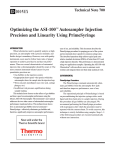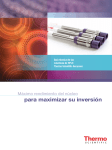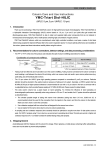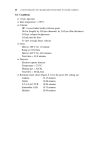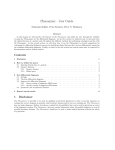Download HPLC Basics, Equipment, and Troubleshooting
Transcript
HPLC Basics, Equipment, and Troubleshooting HPLC Basics, Equipment, and Troubleshooting explains chromatography in practical terms from the ground up Official Denmark Distributor www.md-scientific.dk HPLC Basics, Equipment, and Troubleshooting HPLC Basics, Equipment, and Troubleshooting explains chromatography in practical terms from the ground up Who should take this course? If you use chromatography on the job and would like a better understanding of how it works, “HPLC Basics, Equipment, and Troubleshooting” is the course for you. It’s designed for chemists and biochemists who use HPLC as a regular part of their jobs, but technicians with some HPLC experience will also find the course valuable. No previous HPLC training is assumed; however, much of the course will appeal to the experienced chemists who want a firm grounding in the basics of HPLC. What does it cover? “HPLC Basics, Equipment, and Troubleshooting” explains chromatography in practical terms from the ground up. Here’s what you’ll learn in this online course: • The basic principles of HPLC • The five fundamental HPLC modes • The easy and logical way to adjust experimental variables to get a good separation • The best approach to use for various chromatographic applications • How to maximize column life • Special techniques such as gradient elution, quantitation, and sample pretreatment • The operating principles of each module in an HPLC system • Proven techniques for systematic problem-solving and instrument maintenance • The most effective, timesaving, money saving approaches to preventing common hardware problems and method failures. What will I get from this course? You will acquire a good understanding of the fundamentals of chromatography and learn simple tips and guidelines to make your chromatography work easier and more efficient. What you learn will demystify your instrument. You’ll find that all of the perplexing and frustrating problems your experience have simple and logical solutions. And, better yet, you’ll learn that most of these problems are preventable. The techniques you learn from this course will make you more effective at work and save you big headaches! If you’ve never taken a formal course or if you need a refresher, it’s time to learn HPLC the right way. Students tell us that this “extremely practical course” is a must for everyone who uses HPLC. Instructors The course was designed by John Dolan, Tom Jupille, and Lloyd Snyder. This class is taught by Tom Jupille. Tom has been a practising chromatographer for more than 30 years, during which he has written more than 30 papers on chromatography and related subjects. He worked primarily in gas chromatography in the late ‘60s, switching to thin-layer chromatography in the early ‘70s and then to HPLC and ion chromatography in late ‘70s. His career has focused on instrument and column development and user support, providing a broad foundation of practical experience to call on as an instructor. He is probably best known as the moderator of the popular Chromatography Forum on-line chromatography discussion group. Official Denmark Distributor www.md-scientific.dk Course Detail Below are listed each section and sub-section of the class. A brief summary of each sub-section is given first. After the subsection in parentheses is the approximate running time of that module. Section 1. Isocratic HPLC Basics What is HPLC? (15 mins) A summary of the history of HPLC, how it developed into the ubiquitous technique we use today, and some of the standard vocabulary and terminology. Separation Chemistry (15 mins) An overview of the different chemical mechanisms used in HPLC: • Reversed phase • Normal phase & HILIC • Ion exchange • Ion pair • Size Exclusion (GFC & GPC) Key Measurements: Retention and Selectivity (19 mins) A number of parameters are used to describe an HPLC separation. In this section we will define and explore the significance of k’ (retention) and alpha (selectivity). Key Measurements: Efficiency and Resolution (16 mins) A number of parameters are used to describe an HPLC separation. In this section we will define and explore the significance of N (efficiency) and Rs (resolution). Controlling Resolution (18 mins) Resolution (Rs) is the key parameter that describes the quality of a separation. In this section we will look at how Rs can be controlled by using k’, alpha, and N Tailing and Fronting (6 mins) The Gaussian peak shape is an idealization that is seldom seen in practice. We will explore the standard measurements used to describe deviations from that ideal: the USP “Tailing Factor” and the ASTM “Asymmetry Factor”. Section 2. Gradient HPLC Basics Gradient is Just Like Isocratic (17 mins) Gradient (“solvent programming”) HPLC is actually more similar to isocratic (“constant solvent”) than it is different. Understanding those similarities can take much of the mystery out of gradients. Gradient is Different From Isocratic (13 mins) Despite the similarities, there are some key differences between gradient and isocratic HPLC. We ignore those differences at our peril. Gradient Hardware Issues (12 mins) In this section, we will explore some of the hardware issues that complicate method transfer in gradient HPLC Section 3. HPLC Columns Dynamics of Column Performance (18 mins) The “performance” of a liquid chromatography column is measured by the plate number (N). In this section, we will explore the factors that influence N: column dimensions, packing particle size, solvent flow, temperature, and analyte molecular weight. Future Directions (15 mins) A brief look through the crystal ball at what HPLC might look like in the future with the potential impact of UHPLC, solid-core column packings, and monolithic columns. Section 4. Reversed-phase HPLC Mechanism (11 mins) “Reversed-phase” chromatography is unquestionably the most widely used form of HPLC. In this section we will take a look at the underlying mechanism and its implications for various types of samples. Official Denmark Distributor www.md-scientific.dk Solvent Selection (15 mins) The most widely used solvents for reversed phase are water, acetonitrile, methanol, and tetrahydrofuran. In this section we will look at the reasons why, and the general approach used for mobile phase selection and optimization. Bonded Phase Columns (16 mins) Most HPLC columns are based on silica gel to which has been grafted a (relatively) non-polar moiety. Here’s why, how it’s done, and the implications for separation mechanism --and how this technology has contributed to the overwhelming popularity of reversed-phase as a separation mechanism. Column Selectivity (10 mins) Even columns of the same nominal functionality (e.g., “C18”) can vary tremendously in selectivity. We’ll look at the parameters that determine selectivity and how to compare selectivity systematically. Section 5. pH & Ionization Effects Controlling Ionization (15 mins) By implication, reversed-phase chromatography works with neutral molecules. Weak acids and bases, which can be partially ionized, complicate things. In this section we will explore the impact of ionization and pH on reversed-phase separation. Ion-Pair Chromatography (15 mins) As we saw in Section 1b, ion-pair chromatography behaves like a hybrid of reversed-phase and ion-exchange. That makes it the ideal technique for mixtures of neutral and ionized compounds. We’ll look at how to control the separation chemistry and avoid (or live with) some of the pitfalls. Section 6. Normal-phase, HILIC, Ion-exchange, & Size-exclusion Normal-Phase Chromatography (15 mins) Normal phase is the “reverse of reverse phase”. In this section we’ll look at the mechanism of normal phase, its implications for selectivity, and some of the reasons why it has proven to be less popular than reversed-phase. Hydrophilic Interaction Chromatography (HILIC) (7 mins) HILIC is technically a subset of normal-phase chromatography, but it is used with solvents that we typically associate more with reversed-phase. That make it the ideal technique for the analysis of very polar molecules and often the best alternative to reversed-phase. Ion-Exchange Chromatography (10 mins) In HPLC practice, ion exchange is used primarily for the analysis of very small (usually inorganic) strong acid or base compounds or for the analysis of large biopolymers. We’ll look at how it works: the mechanism and the major control parameters. Size-Exclusion Chromatography (13 mins) SEC is arguably not chromatography at all, but rather a “first cousin my marriage”. We’ll look at the reasons why, the types of samples to which it is appropriate and how to minimize some of the accompanying problems. Section 7. HPLC Equipment: Reservoirs & Pumps Reservoirs and Degassing (12 mins) Why is degassing so important, the pros and cons of different degassing techniques, and quick checks for inlet blockages. Pumps (19 mins) The pros and cons of different pump designs, potential failure modes and their symptoms, and basic preventive maintenance. Section 8. HPLC Equipment: Tubing & Injectors Tubing (15 mins) The choice of tubing materials and dimensions; good practice for cutting tubing. Consequences (symptoms) of poor choice or technique. Official Denmark Distributor www.md-scientific.dk Fittings (10 mins) We’ll look at the design of HPLC fittings with an emphasis on interchangeability from different vendors, and good assembly technique. We’ll also cover the symptoms of poor assembly, and ways to avoid the most common problems. Injectors (16 mins) We’ll look at the way injection valves work, and the consequences for reliable operation. We’ll cover potential failure modes (and how to avoid them). The different designs of autosamplers will be reviewed along with a summary of the pros and cons of each. Section 9. HPLC Equipment: Columns Overview (4 mins) A column is, in fact, a consumable item, but many column die prematurely. We’ll look at the major causes of causes of column failure and early warning symptoms of impending column death Physical Problems (20 mins) Physical causes of column death typically involve column inlet flow-profile anomalies: partially-plugged frits, trapped air, & head spaces. We’ll look at the symptoms of each, possible fixes, and prevention. Non-Column Problems (Part 1) (6 mins) Sometimes we blame the column for things that are not the column’s problem. In this section, we will look at the symptoms and prevention of flow variations and extra-column volume. Non-Column Problems (Part 2) (11 mins) Continuing the discussion of non-column problems, we’ll look at temperature effects & late-eluting compounds. Chemical Problems (19 mins) Chemical causes of column death include contamination, column degradation, overload, the strong diluent effect, injection volume, on-column degradation, mobile phase variations, and sub-optimal storage conditions. We’ll look at diagnostic symptoms for each , as well as possible column regeneration techniques. Documentation (12 mins) Many problems are the result of “pilot error” and many of these problems, in turn, are the result of ambiguous documentation. We’ll look at some examples as well as ways to avoid the problem. Section 10. HPLC Equipment: Detectors UV Detectors (22 mins) The most commonly used HPLC detectors are based on UV or visible light absorbance. The “Acronym soup” includes: UV, VWD, PDA, DAD; we’ll cover what they mean, how they work, potential problems and preventive maintenance. Gradient Baseline Issues (12 mins) Using a UV detector with gradients poses a unique set of problems. Here’s how to diagnose and (sometimes!) fix them. Other Detectors (12 mins) More acronym soup: RI, ECD, ELSD, CAD, FD, LC-MS; an overview of other detector types. Section 11. Quantization Measuring Peak Area (15 mins) Quantitative HPLC depends on relating the amount of analyte injected to the area of the resulting peak. In this section we will cover how the area measurement (integration) is carried out and the consequences for accurate and precise measurement, as well as how to allocate areas when peaks are not fully resolved. Calibration Issues (8 mins) Calibration is the determination of the relationship between peak area and amount injected. We’ll look at, linearity, response factors, linear range, Limit of Detection (LOD) and Limit of Quantitation (LOQ) Reproducibility Issues (15 mins) In many analyses, HPLC is only the final step in a more or less complex sample workup procedure. We’ll look at techniques for identifying the dominant sources of error, including the “pseudo internal standard” trick. Official Denmark Distributor www.md-scientific.dk Section 12. UHPLC What’s Different? (14 mins) The latest “buzz-acronym” is UHPLC (“Ultra-High Performance Liquid Chromatography”). In many respects, UHPLC is simply a continuation of the HPLC trend to smaller particles , but there are some key differences that can complicate the transition. Transferring / Scaling Methods (10 mins) We’ll look at the steps required to adapt UHPLC methods to HPLC instruments and columns (and vice versa) Possible Surprises (9 mins) An overview of the common pitfalls when moving from HPLC to UHPLC, with an emphasis on “Good Chromatographic Hygiene” Section 13. Performance Qualification This section presents a detailed suite of tests used to verify performance of the HPLC system and its components. Overview (5 mins) Why PQ? Relationship between PQ and System Suitability Pump & Detector Checks (11 mins) POST; Siphon test; Leak-down test; Flow accuracy; Detector noise & drift On-line Mixing Checks (9 mins) Step-test; GPV test; Dwell volume measurement; Linearity check Chromatographic Checks (9 mins) Oven temperature accuracy & range; Detector wavelength accuracy; Injector repeatability, carryover, & linearity; All-up system test. Section 14. Troubleshooting & Diagnostics Preventive Maintenance, Documentation, and Troubleshooting (9 mins) How to consistently do good chromatography A Troubleshooting Checklist (29 mins) A comprehensive list of symptoms, and what to look for as possible causes: • No peaks • Missing peaks • Extra peaks • Wrong retention time • Poor efficiency or peak shape • Poor resolution • Poor precision • Baseline noise or drift • Pressure problems • Leaks • Column lifetime For more information and to discuss your training requirements, contact: MD Scientific ApS Klokkerfaldet 23 8210 Aarhus V Denmark 70 27 85 65 70 27 85 66 (fax) [email protected] www.md-scientific.dk






